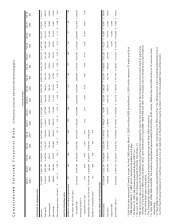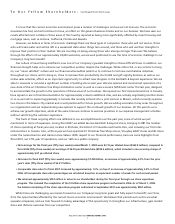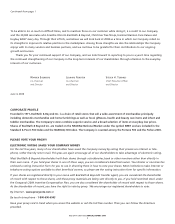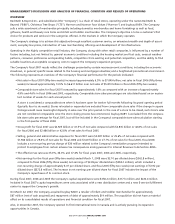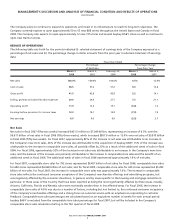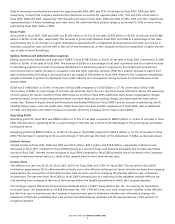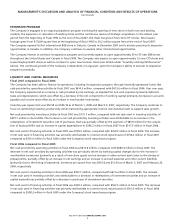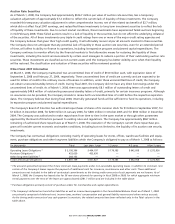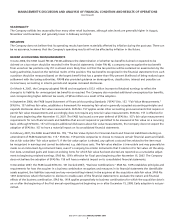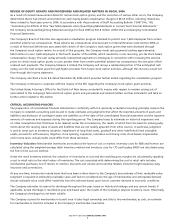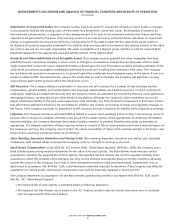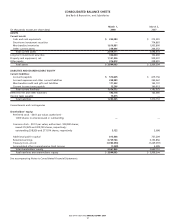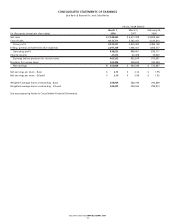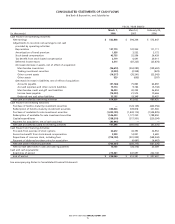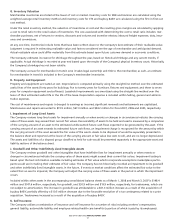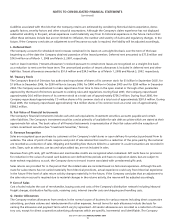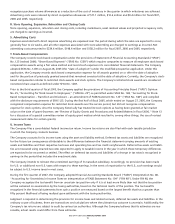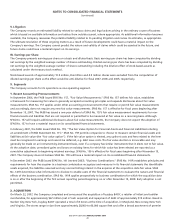Bed, Bath and Beyond 2007 Annual Report Download - page 12
Download and view the complete annual report
Please find page 12 of the 2007 Bed, Bath and Beyond annual report below. You can navigate through the pages in the report by either clicking on the pages listed below, or by using the keyword search tool below to find specific information within the annual report.
BED BATH& BEYOND ANNUAL REPORT 2007
10
Impairment of Long-Lived Assets: The Company reviews long-lived assets for impairment annually or when events or changes
in circumstances indicate the carrying value of these assets may exceed their current fair values. Recoverability of assets to be
held and used is measured by a comparison of the carrying amount of an asset to the estimated undiscounted future cash flows
expected to be generated by the asset. If the carrying amount of an asset exceeds its estimated future cash flows, an impairment
charge is recognized for the amount by which the carrying amount of the asset exceeds the fair value of the assets. Assets to
be disposed of would be separately presented in the balance sheet and reported at the lower of the carrying amount or fair value
less costs to sell, and are no longer depreciated. The assets and liabilities of a disposal group classified as held for sale would be
presented separately in the appropriate asset and liability sections of the balance sheet.
Goodwill and Other Indefinitely Lived Intangible Assets: The Company reviews goodwill and other intangibles that have
indefinite lives for impairment annually or when events or changes in circumstances indicate the carrying value of these assets
might exceed their current fair values. Impairment testing is based upon the best information available including estimates of fair
value which incorporate assumptions marketplace participants would use in making their estimates of fair value. The Company
has not historically recorded an impairment to its goodwill and other indefinitely lived intangible assets. In the future, if events or
market conditions affect the estimated fair value to the extent that an asset is impaired, the Company will adjust the carrying
value of these assets in the period in which the impairment occurs.
Self Insurance: The Company utilizes a combination of insurance and self insurance for a number of risks including workers’
compensation, general liability, automobile liability and employee related health care benefits (a portion of which is paid by its
employees). Liabilities associated with the risks that the Company retains are estimated by considering historical claims experience,
demographic factors, severity factors and other actuarial assumptions. Although the Company’s claims experience has not dis-
played substantial volatility in the past, actual experience could materially vary from its historical experience in the future. Factors
that affect these estimates include but are not limited to: inflation, the number and severity of claims and regulatory changes. In
the future, if the Company concludes an adjustment to self insurance accruals is required, the liability will be adjusted accordingly.
Litigation: The Company records an estimated liability related to various claims and legal actions arising in the ordinary course of
business which is based on available information and advice from outside counsel, where appropriate. As additional information
becomes available, the Company reassesses the potential liability related to its pending litigation and revises its estimates, as
appropriate. The ultimate resolution of these ongoing matters as a result of future developments could have a material impact on
the Company’s earnings. The Company cannot predict the nature and validity of claims which could be asserted in the future, and
future claims could have a material impact on its earnings.
Store Opening, Expansion, Relocation and Closing Costs: Store opening, expansion, relocation and closing costs, including
markdowns, asset residual values and projected occupancy costs, are charged to earnings as incurred.
Stock-Based Compensation: Under SFAS No. 123 (revised 2004), “Share-Based Payment” (SFAS No. 123R), the Company uses a
Black-Scholes option-pricing model to determine the fair value of its stock options. The Black-Scholes model includes various
assumptions, including the expected life of stock options, the expected risk free interest rate and the expected volatility. These
assumptions reflect the Company’s best estimates, but they involve inherent uncertainties based on market conditions generally
outside the control of the Company. As a result, if other assumptions had been used, total stock-based compensation cost, as
determined in accordance with SFAS No. 123R, could have been materially impacted. Furthermore, if the Company uses different
assumptions for future grants, stock-based compensation cost could be materially impacted in future periods.
The Company determines its assumptions for the Black-Scholes option-pricing model in accordance with SFAS No. 123R and/or
SAB No. 107, “Share-Based Payment”.
• The expected life of stock options is estimated based on historical experience.
• The expected risk free interest rate is based on the U.S. Treasury constant maturity interest rate whose term is consistent
with the expected life of the stock options.
MANAGEMENT’S DISCUSSION AND ANALYSIS OF FINANCIAL CONDITION AND RESULTS OF OPERATIONS
(continued)


